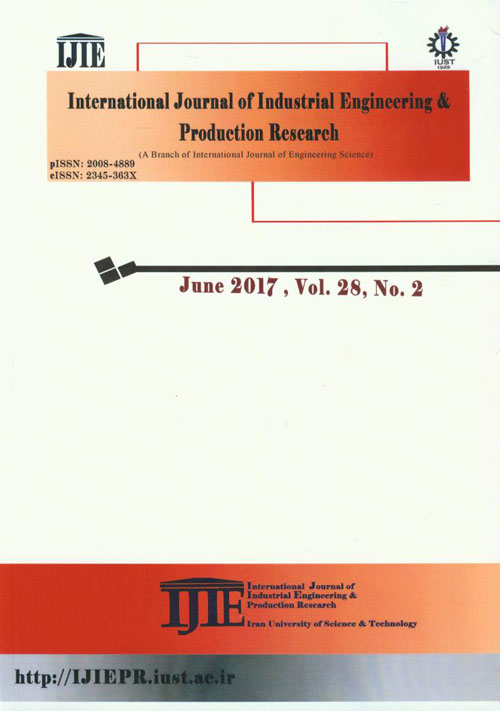فهرست مطالب

International Journal of Industrial Engineering and Productional Research
Volume:28 Issue: 2, Jun 2017
- 120 صفحه،
- تاریخ انتشار: 1396/04/08
- تعداد عناوین: 8
-
-
Pages 101-111In this research, an integrated inventory model for non-instantaneous deteriorating items is analyzed when demand is sensitive to changes in price. The price used in this research is a time-dependent function of the initial selling price and the discount rate. To control the deterioration rate of items at the storage facility, investment in preservation technology is incorporated. To provide a general framework to the model, an arbitrary holding cost rate is used. Toward the end of the paper, a numerical case is given to approve the model and the impacts of the key parameters of the model are studied by sensitivity analysis to deduce managerial insights.Keywords: Inventory, Non-instantaneous deterioration, Price-dependent demand, Variable holding cost, Dynamic pricing
-
Pages 113-128Public transportation has been one of the most important research fields in the two last decades. The purpose of this paper is to create a schedule for public transport fleets such as buses and metro trains with the goal of minimizing the total transfer waiting time. We extend previous research works in the field of transit schedule with considering headways of each route as decision variables. In this paper, we formulate the problem as a mixed integer linear programming model and solve it using ILOG CPLEX solver. For large-scale test instances, we develop a metaheuristic based on the scatter search algorithm to obtain good solutions in a reasonable CPU run times. Finally, in the computational section, the efficiency of the proposed model and developed algorithm are compared with the existing results in the literature on a real railway network.Keywords: Transportation, scheduling, scatter search metaheuristic
-
Pages 129-149Nowadays, with a growing body of features and technologies, supply chain management is being widely used to coordinate and optimize key processes such as increasing customer satisfaction, facilitating the processes, and enhancing product quality. In recent years, the emergence of IT and new business environments has led to the development of electronic supply chains. In order to use and benefit from the privileges of e-supply chains, organizations must identify the key factors in the implementation of e-supply chain management so that they can monitor the organization's current and future activities and take action to identify and modify and fix any bugs. The present study aimed at identifying these factors. Based on the available theoretical foundations and expert opinions, the factors affecting the implementation of electronic supply chain management were identified in seven factors with 31 indicators. To determine the weight of the identified factors considering the lack of independence between them, an integrated type-2 fuzzy AHP and type-2 fuzzy DEMATEL approach was used. Results showed that computer-based technology, infrastructure, inter-organizational relationships, and information are the most important factors.Keywords: E-supply chain, E-supply chain management, type-2 fuzzy, Group decision making
-
Pages 151-161A teaching-learning-based optimization (TLBO) algorithm is a new population-based algorithm applied in some applications in the literature successfully. Moreover, a genetic algorithm (GA) is a popular tool employed widely in many disciplines of engineering. In this paper, a hybrid GA-TLBO algorithm is proposed for the capacitated three-stage supply chain network design (SCND) problem. The SCND problem as a strategic level decision-making problem in supply chain management is an NP-hard class of computational complexity. To escape infeasible solutions emerged in the problem of interest due to realistic constraints, combination of a random key and priority-base encoding scheme is also used. To assess the quality of the proposed hybrid GA-TLBO algorithm, some numerical examples are conducted. Then, the results are compared with the GA, TLBO, differential evolution (DE) and branch-and -bound algorithms. Finally, the conclusion is provided.Keywords: Supply chain network design, Teaching learning-based optimization, Genetic algorithm, Priority-base encoding
-
Pages 163-174In this paper, a comprehensive mathematical model for designing an electric power supply chain network via considering preventive maintenance under risk of network failures is proposed. The risk of capacity disruption of the distribution network is handled via using a two-stage stochastic programming as a framework for modeling the optimization problem. An applied method of planning for the network design and power generation and transmission system via considering failures scenarios, as well as network preventive maintenance schedule, is presented. The aim of the proposed model is to minimize the expected total cost consisting of power plants set-up, power generation and the maintenance activities. The proposed mathematical model is solved by an efficient new accelerated Benders decomposition algorithm. The proposed accelerated Benders decomposition algorithm uses an efficient acceleration mechanism based on the priority method which uses a heuristic algorithm to efficiently cope with computational complexities. A large number of considered scenarios are reduced via using a k-means clustering algorithm to decrease the computational effort for solving the proposed two-stage stochastic programming model. The efficiencies of the proposed model and solution algorithm are examined using data from the Tehran Regional Electric Company. The obtained results indicate that solutions of the stochastic programming are more robust than the obtained solutions provided by a deterministic model.Keywords: Power supply network, Two-stage stochastic programming, Preventive maintenance, Accelerated benders decomposition, K-means clustering
-
Pages 175-187The reliability and safety of any system is the most important qualitative characteristic of a system. This qualitative characteristic is of particular importance in systems whose functions are under various stresses, such as high temperature, high speed, high pressure, etc. A considerable point, which is rarely taken into account when calculating the reliability and safety of systems, is the presence of dependency among subsystems, and this dependency causes various failures in a system, one of the most important of which is the common cause failure (CCF). Failing to consider common cause failures in the calculation of system reliabilities, leads to optimistic estimations of system reliability rates, which results in too much trust in the system. In this paper, first we deal with identifying the reliability of the input of a dynamic positioning system consisting of different environmental sensors and various positioning systems with the aid of PBS and FFBD techniques. Then, we will calculate and allocate the above-mentioned reliability with the aid of a RBD. The common cause failures of different subsystems were considered in calculating the reliability of the previously mentioned system, with the aid of IEC 61508 standard, and then the degree of the effectiveness of common cause failures on the reliability of the studied system, was obtained. Finally, by considering different assumptions for the system under study, it was proved that the less the amount of the reliability of dependent components is, the higher the effectiveness of common cause failures on the system reliability will beKeywords: Reliability, Dependent Failure, Common Cause Failure, Reliability Block Diagram, Dynamic Positioning System
-
Pages 189-199Today, many companies after achieving improvements in manufacturing operations are focused on the improvement of distribution systems and have long been a strong tendency to optimize the distribution network in order to reduce logistics costs that the debate has become challenging. Improve the flow of materials, an activity considered essential to increase customer satisfaction. In this study, we benefit cross docking method for effective control of cargo flow to reduce inventory and improve customer satisfaction. Also every supply chain is faced with risks that threaten its ability to work effectively. Many of these risks are not in control but can cause great disruption and costs for the supply chain process. In this study we are looking for a model to collect and deliver the demands for the limited capacity vehicle in terms of disruption risk finally presented a compromised planning process. In fact, we propose a framework which can consider all the problems on the crisis situation for decision-making in these conditions, by preparing a mathematical model and software gams for the following situation in a case study. In the first step, the results presented in mode of a two-level planning then the problem expressed in form of a multi-objective optimization model and the results was explained.Keywords: Cross dock, vehicle routing problem, scheduling, disruption risk
-
A game theoretical approach for pricing in a two-level supply chain considering advertising and servicingPages 201-216This paper considers the advertising, pricing, and service decisions simultaneously to coordinate the supply chain with a manufacturer and a retailer. The amount of market demand is influenced by advertising, pricing and service decisions. In this paper, three well-known approaches to the game theory, including the Nash, the Stackelberg-retailer, and the cooperative game are exploited to study the effects of these policies on the supply chain. Using these approaches, we identify optimal strategies in each case for the manufacturer and the retailer. Then, we will compare the outcomes of each strategy thus developed. The results show that, compared with the Nash game, the Stackelberg-retailer game yields higher profits for the retailer, the manufacturer, and the whole system. The cooperative game yields the highest profits. Finally, the Nash bargaining model will be presented and explored to investigate the possibilities for profit sharing.Keywords: Supply chain, Services, advertising, Pricing, Game theory


